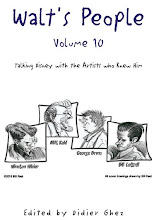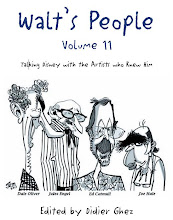Let's admit it, I am a little puzzled when it comes to reviewing a products like the newly released Walt Disney Animation Studios The Archive Series: Walt Disney's Nine Old Men: The Flipbooks. As I mentioned a few times in the past there is more and more a tendency today to see two completely different types of Disney books being released: purely visual ones with little text (The Archives Series being a prime example) or in-depth ones with zero or close to zero illustratons (Walt's People or Michael Barrier's and Jim Korkis' books for example). This is, of course, linked to Disney's approval process when it comes to "art books" and books containing Disney illustrations.
So when Disney Editions releases a new product, I always hope that if it is a purely visual book it will contain some never-seen-before documents and that otherwise it will be one of those rare exceptions (like Canemaker's or JB Kaufman's books) which will contain both in-depth research and great illustrations.
Unfortunately I am often disappointed.
But in the case of Walt Disney Animation Studios The Archive Series: Walt Disney's Nine Old Men: The Flipbooks I have to forget my disappointment, since from day one the title said it all. This is a series of flipbooks, with all the limitations that this entails: one scene per flipbook, no text in the books themselves, artwork that, in some ways, we are already very familiar with.
If one accepts this concept for what it is worth, then one has to admit that the idea is beautifully executed: the scenes selected are emblematic, the packaging is beautiful, the books, while small (like sketchbooks should be) respect the quality standards of The Archives Series.
And I adored the small booklet which comes with the sketchbooks and which contains profiles of the Nine Old Men by John Canemaker, Don Hahn, Andreas Deja, Glen Keane, Eric Goldberg, John Musker, Ron Clements, Bob Kurtz and Dale Baer.
So when Disney Editions releases a new product, I always hope that if it is a purely visual book it will contain some never-seen-before documents and that otherwise it will be one of those rare exceptions (like Canemaker's or JB Kaufman's books) which will contain both in-depth research and great illustrations.
Unfortunately I am often disappointed.
But in the case of Walt Disney Animation Studios The Archive Series: Walt Disney's Nine Old Men: The Flipbooks I have to forget my disappointment, since from day one the title said it all. This is a series of flipbooks, with all the limitations that this entails: one scene per flipbook, no text in the books themselves, artwork that, in some ways, we are already very familiar with.
If one accepts this concept for what it is worth, then one has to admit that the idea is beautifully executed: the scenes selected are emblematic, the packaging is beautiful, the books, while small (like sketchbooks should be) respect the quality standards of The Archives Series.
And I adored the small booklet which comes with the sketchbooks and which contains profiles of the Nine Old Men by John Canemaker, Don Hahn, Andreas Deja, Glen Keane, Eric Goldberg, John Musker, Ron Clements, Bob Kurtz and Dale Baer.























1 comment:
It’s interesting the man who authored this book creates modern animation without the use of hand drawn cells, perhaps he wanted to re-create the old method for all to appreciate and enjoy.
Post a Comment